The Role of Narrative Therapy: A Study on its Impact on Children
VerifiedAdded on 2023/06/10
|13
|3992
|180
Report
AI Summary
This report provides a comprehensive overview of narrative therapy and its significance in treating mental health issues in children. It explores the use of narration to address trauma and mental disturbances, highlighting the importance of understanding both dominant and subjugated perspectives. The report emphasizes the vulnerability of children and the need for careful handling of their emotions, discussing how misinterpretations of their behavior can lead to negative self-perception. It reviews literature on incorporating play therapy and Erik Erikson’s psychosocial theory to facilitate healthy development, addressing techniques like externalization to help children identify external causes of their problems. The report also examines the role of family involvement and the importance of understanding a child’s emotional state through play sessions, ultimately aiming to bridge the gap in existing literature by elaborating on the complex emotional experiences of children aged 2 to 18.

Running head: NARRATIVE THERAPY
NARRATIVE THERAPY
Name of the Student:
Name of the University:
Author Note:
NARRATIVE THERAPY
Name of the Student:
Name of the University:
Author Note:
Paraphrase This Document
Need a fresh take? Get an instant paraphrase of this document with our AI Paraphraser
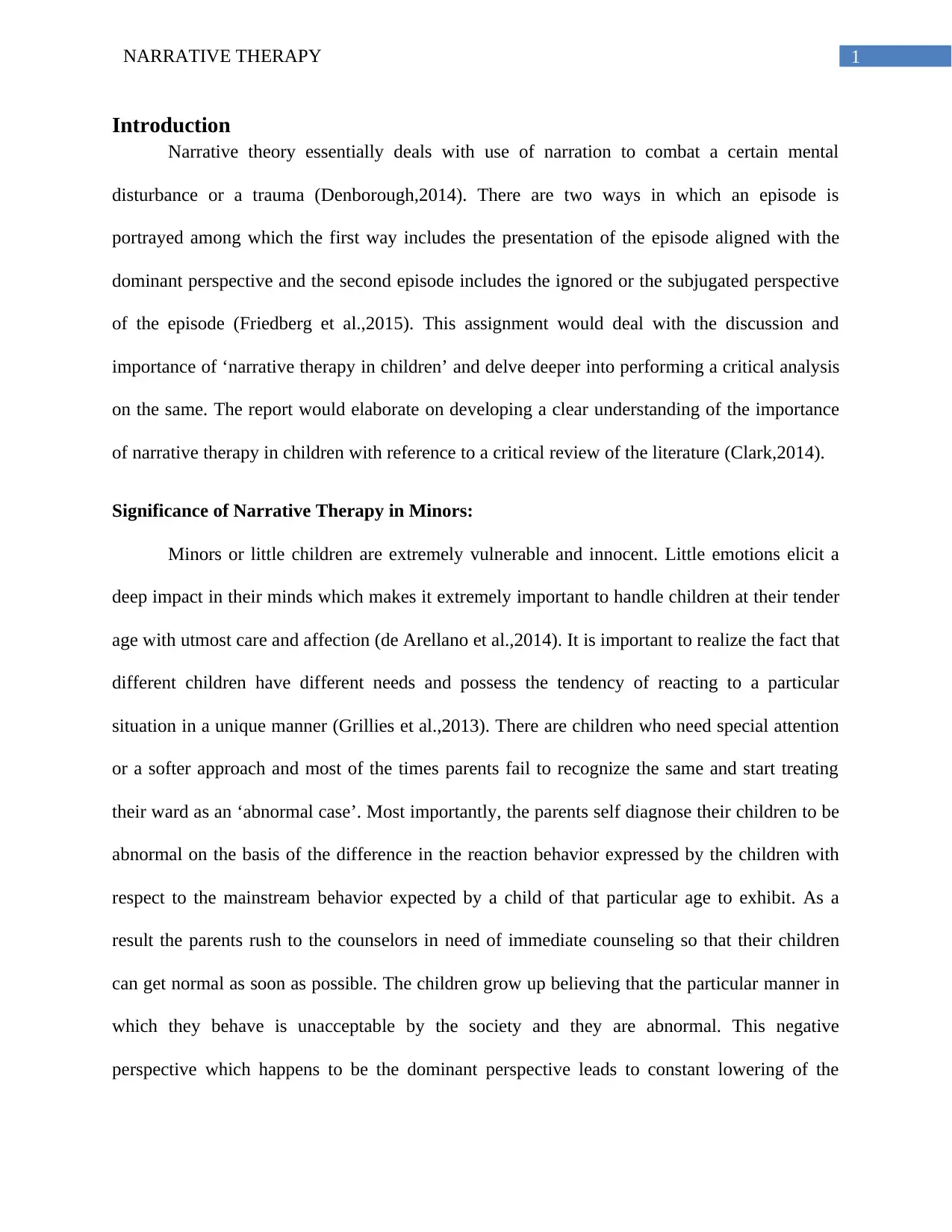
1NARRATIVE THERAPY
Introduction
Narrative theory essentially deals with use of narration to combat a certain mental
disturbance or a trauma (Denborough,2014). There are two ways in which an episode is
portrayed among which the first way includes the presentation of the episode aligned with the
dominant perspective and the second episode includes the ignored or the subjugated perspective
of the episode (Friedberg et al.,2015). This assignment would deal with the discussion and
importance of ‘narrative therapy in children’ and delve deeper into performing a critical analysis
on the same. The report would elaborate on developing a clear understanding of the importance
of narrative therapy in children with reference to a critical review of the literature (Clark,2014).
Significance of Narrative Therapy in Minors:
Minors or little children are extremely vulnerable and innocent. Little emotions elicit a
deep impact in their minds which makes it extremely important to handle children at their tender
age with utmost care and affection (de Arellano et al.,2014). It is important to realize the fact that
different children have different needs and possess the tendency of reacting to a particular
situation in a unique manner (Grillies et al.,2013). There are children who need special attention
or a softer approach and most of the times parents fail to recognize the same and start treating
their ward as an ‘abnormal case’. Most importantly, the parents self diagnose their children to be
abnormal on the basis of the difference in the reaction behavior expressed by the children with
respect to the mainstream behavior expected by a child of that particular age to exhibit. As a
result the parents rush to the counselors in need of immediate counseling so that their children
can get normal as soon as possible. The children grow up believing that the particular manner in
which they behave is unacceptable by the society and they are abnormal. This negative
perspective which happens to be the dominant perspective leads to constant lowering of the
Introduction
Narrative theory essentially deals with use of narration to combat a certain mental
disturbance or a trauma (Denborough,2014). There are two ways in which an episode is
portrayed among which the first way includes the presentation of the episode aligned with the
dominant perspective and the second episode includes the ignored or the subjugated perspective
of the episode (Friedberg et al.,2015). This assignment would deal with the discussion and
importance of ‘narrative therapy in children’ and delve deeper into performing a critical analysis
on the same. The report would elaborate on developing a clear understanding of the importance
of narrative therapy in children with reference to a critical review of the literature (Clark,2014).
Significance of Narrative Therapy in Minors:
Minors or little children are extremely vulnerable and innocent. Little emotions elicit a
deep impact in their minds which makes it extremely important to handle children at their tender
age with utmost care and affection (de Arellano et al.,2014). It is important to realize the fact that
different children have different needs and possess the tendency of reacting to a particular
situation in a unique manner (Grillies et al.,2013). There are children who need special attention
or a softer approach and most of the times parents fail to recognize the same and start treating
their ward as an ‘abnormal case’. Most importantly, the parents self diagnose their children to be
abnormal on the basis of the difference in the reaction behavior expressed by the children with
respect to the mainstream behavior expected by a child of that particular age to exhibit. As a
result the parents rush to the counselors in need of immediate counseling so that their children
can get normal as soon as possible. The children grow up believing that the particular manner in
which they behave is unacceptable by the society and they are abnormal. This negative
perspective which happens to be the dominant perspective leads to constant lowering of the
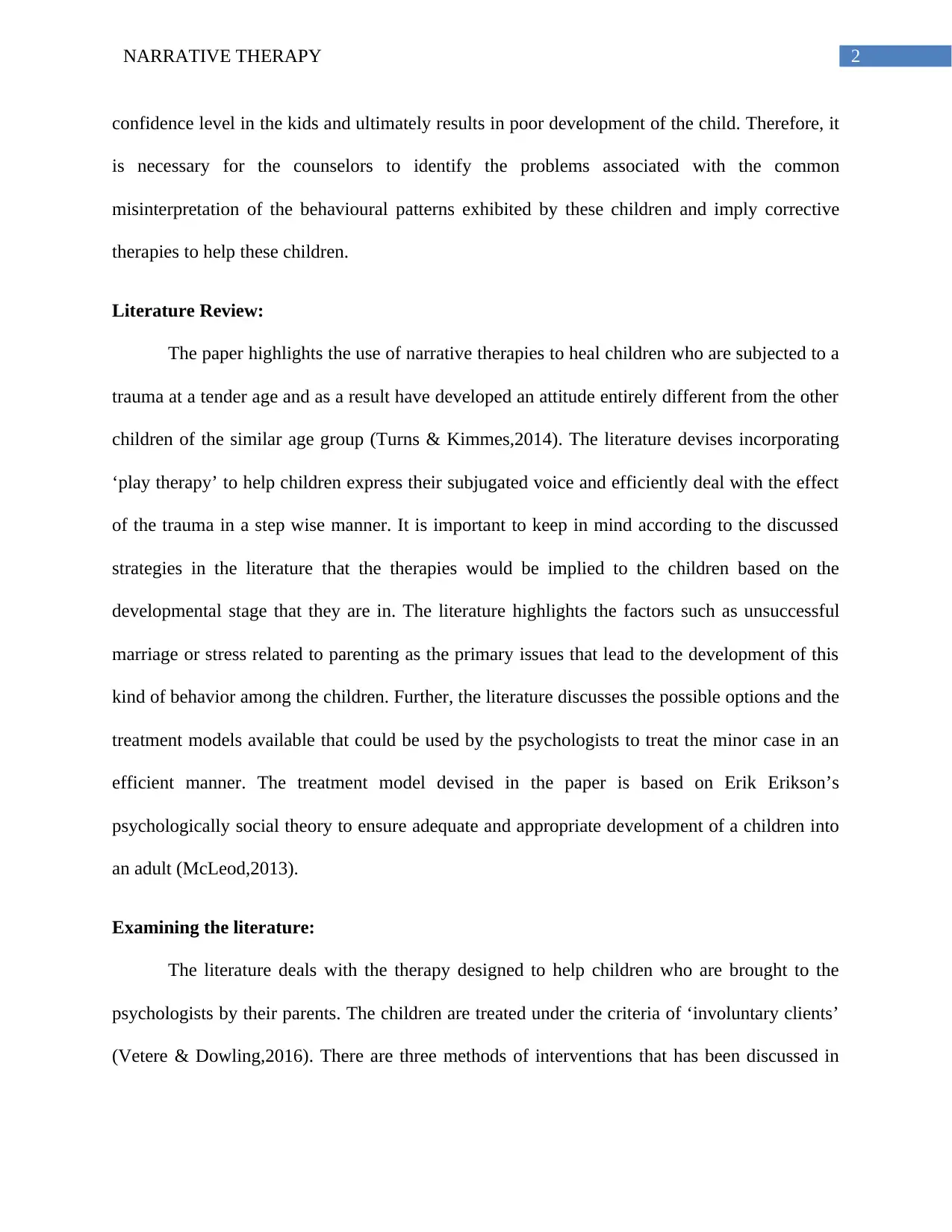
2NARRATIVE THERAPY
confidence level in the kids and ultimately results in poor development of the child. Therefore, it
is necessary for the counselors to identify the problems associated with the common
misinterpretation of the behavioural patterns exhibited by these children and imply corrective
therapies to help these children.
Literature Review:
The paper highlights the use of narrative therapies to heal children who are subjected to a
trauma at a tender age and as a result have developed an attitude entirely different from the other
children of the similar age group (Turns & Kimmes,2014). The literature devises incorporating
‘play therapy’ to help children express their subjugated voice and efficiently deal with the effect
of the trauma in a step wise manner. It is important to keep in mind according to the discussed
strategies in the literature that the therapies would be implied to the children based on the
developmental stage that they are in. The literature highlights the factors such as unsuccessful
marriage or stress related to parenting as the primary issues that lead to the development of this
kind of behavior among the children. Further, the literature discusses the possible options and the
treatment models available that could be used by the psychologists to treat the minor case in an
efficient manner. The treatment model devised in the paper is based on Erik Erikson’s
psychologically social theory to ensure adequate and appropriate development of a children into
an adult (McLeod,2013).
Examining the literature:
The literature deals with the therapy designed to help children who are brought to the
psychologists by their parents. The children are treated under the criteria of ‘involuntary clients’
(Vetere & Dowling,2016). There are three methods of interventions that has been discussed in
confidence level in the kids and ultimately results in poor development of the child. Therefore, it
is necessary for the counselors to identify the problems associated with the common
misinterpretation of the behavioural patterns exhibited by these children and imply corrective
therapies to help these children.
Literature Review:
The paper highlights the use of narrative therapies to heal children who are subjected to a
trauma at a tender age and as a result have developed an attitude entirely different from the other
children of the similar age group (Turns & Kimmes,2014). The literature devises incorporating
‘play therapy’ to help children express their subjugated voice and efficiently deal with the effect
of the trauma in a step wise manner. It is important to keep in mind according to the discussed
strategies in the literature that the therapies would be implied to the children based on the
developmental stage that they are in. The literature highlights the factors such as unsuccessful
marriage or stress related to parenting as the primary issues that lead to the development of this
kind of behavior among the children. Further, the literature discusses the possible options and the
treatment models available that could be used by the psychologists to treat the minor case in an
efficient manner. The treatment model devised in the paper is based on Erik Erikson’s
psychologically social theory to ensure adequate and appropriate development of a children into
an adult (McLeod,2013).
Examining the literature:
The literature deals with the therapy designed to help children who are brought to the
psychologists by their parents. The children are treated under the criteria of ‘involuntary clients’
(Vetere & Dowling,2016). There are three methods of interventions that has been discussed in
⊘ This is a preview!⊘
Do you want full access?
Subscribe today to unlock all pages.

Trusted by 1+ million students worldwide
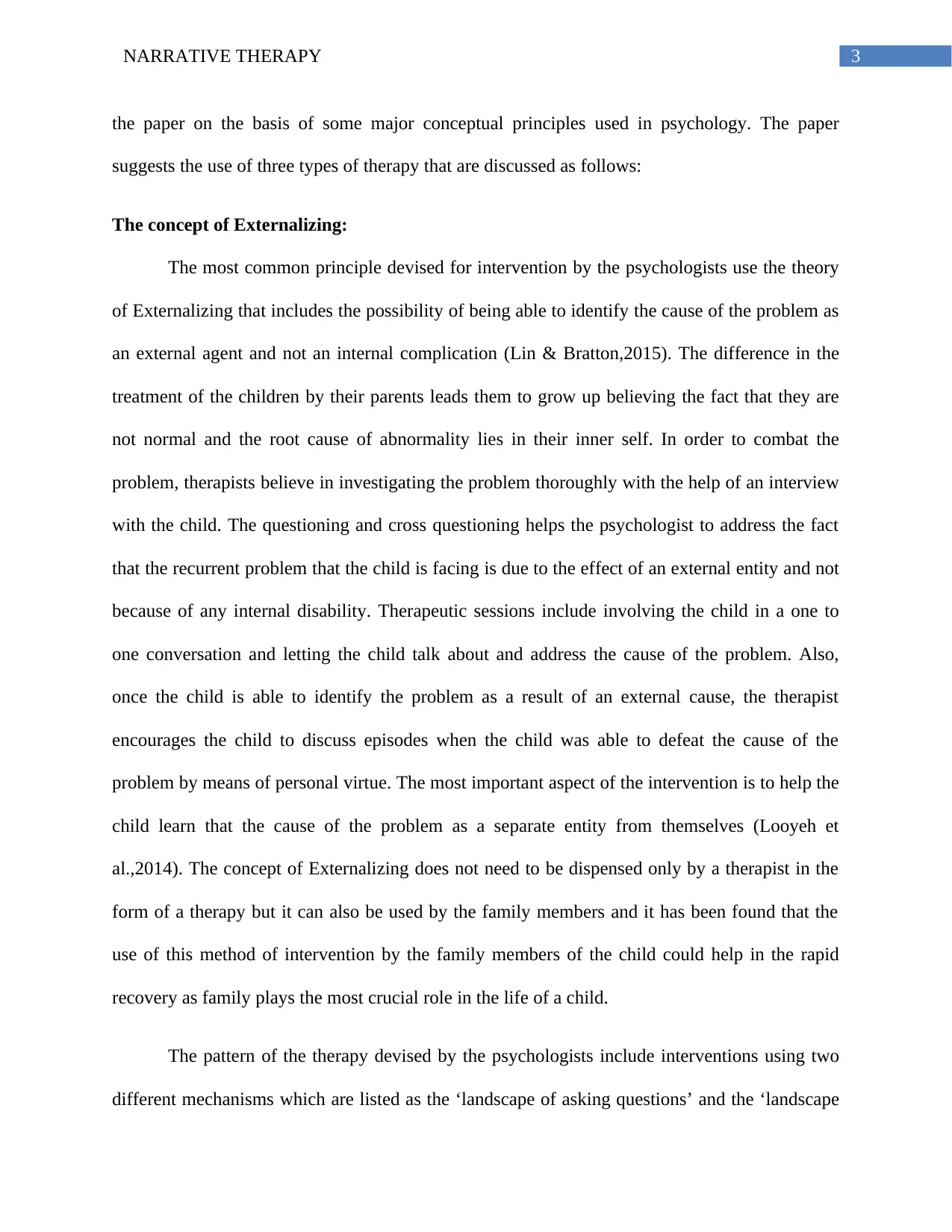
3NARRATIVE THERAPY
the paper on the basis of some major conceptual principles used in psychology. The paper
suggests the use of three types of therapy that are discussed as follows:
The concept of Externalizing:
The most common principle devised for intervention by the psychologists use the theory
of Externalizing that includes the possibility of being able to identify the cause of the problem as
an external agent and not an internal complication (Lin & Bratton,2015). The difference in the
treatment of the children by their parents leads them to grow up believing the fact that they are
not normal and the root cause of abnormality lies in their inner self. In order to combat the
problem, therapists believe in investigating the problem thoroughly with the help of an interview
with the child. The questioning and cross questioning helps the psychologist to address the fact
that the recurrent problem that the child is facing is due to the effect of an external entity and not
because of any internal disability. Therapeutic sessions include involving the child in a one to
one conversation and letting the child talk about and address the cause of the problem. Also,
once the child is able to identify the problem as a result of an external cause, the therapist
encourages the child to discuss episodes when the child was able to defeat the cause of the
problem by means of personal virtue. The most important aspect of the intervention is to help the
child learn that the cause of the problem as a separate entity from themselves (Looyeh et
al.,2014). The concept of Externalizing does not need to be dispensed only by a therapist in the
form of a therapy but it can also be used by the family members and it has been found that the
use of this method of intervention by the family members of the child could help in the rapid
recovery as family plays the most crucial role in the life of a child.
The pattern of the therapy devised by the psychologists include interventions using two
different mechanisms which are listed as the ‘landscape of asking questions’ and the ‘landscape
the paper on the basis of some major conceptual principles used in psychology. The paper
suggests the use of three types of therapy that are discussed as follows:
The concept of Externalizing:
The most common principle devised for intervention by the psychologists use the theory
of Externalizing that includes the possibility of being able to identify the cause of the problem as
an external agent and not an internal complication (Lin & Bratton,2015). The difference in the
treatment of the children by their parents leads them to grow up believing the fact that they are
not normal and the root cause of abnormality lies in their inner self. In order to combat the
problem, therapists believe in investigating the problem thoroughly with the help of an interview
with the child. The questioning and cross questioning helps the psychologist to address the fact
that the recurrent problem that the child is facing is due to the effect of an external entity and not
because of any internal disability. Therapeutic sessions include involving the child in a one to
one conversation and letting the child talk about and address the cause of the problem. Also,
once the child is able to identify the problem as a result of an external cause, the therapist
encourages the child to discuss episodes when the child was able to defeat the cause of the
problem by means of personal virtue. The most important aspect of the intervention is to help the
child learn that the cause of the problem as a separate entity from themselves (Looyeh et
al.,2014). The concept of Externalizing does not need to be dispensed only by a therapist in the
form of a therapy but it can also be used by the family members and it has been found that the
use of this method of intervention by the family members of the child could help in the rapid
recovery as family plays the most crucial role in the life of a child.
The pattern of the therapy devised by the psychologists include interventions using two
different mechanisms which are listed as the ‘landscape of asking questions’ and the ‘landscape
Paraphrase This Document
Need a fresh take? Get an instant paraphrase of this document with our AI Paraphraser

4NARRATIVE THERAPY
of consciousness questions’ (O’Connor,2015). The first methodology is mainly based on the
fulfillment of the condition when the client is able to successfully seclude the problems from the
personal life and is able to win over the problems most of the times. Therapists while using this
method, become observers and closely take note of the exhibited behavior of the child while
combating the personal issue. Being able to combat the problem helps in boosting up the
confidence level of the child and next time the client faces a similar problem, he/ she is able to
solve it on his own without any help based upon the past experiences of being able to overcome
such complicated situations. The second methodology deals with identifying the positive
qualities of the child that had helped them tremendously in being able to fight the problem. With
repeated overcoming, the confidence level of the child rises up by leaps and bounds and
therapists at this stage highlight the positive aspect of the behavior that had helped the child in
critically winning over the situation. By this time, the client has almost regained confidence
boost and the acknowledge of the therapist becomes secondary to them as they are able to
recognize the positive element of the attitude that they possess on their own. The second method
is only incorporated, once it is ensured that the client is highly motivated.
Play Therapy:
Play therapy used by therapists makes use of different kind of props that include puppets,
dolls, crayons or clay models. Playing has been considered to be the most favorite activity of a
child and therapists have built a concept of intervention on the same fact. Actions and reactions
that children exhibit during play sessions help build a better perception about the character of the
child (Kottman,2014). It is generally advised by the therapists to include the family members as
well as the child in a ‘play session’ and make it evident to the parents through the session that the
child is capable of being accepted similar to the way any other child of that age would be
of consciousness questions’ (O’Connor,2015). The first methodology is mainly based on the
fulfillment of the condition when the client is able to successfully seclude the problems from the
personal life and is able to win over the problems most of the times. Therapists while using this
method, become observers and closely take note of the exhibited behavior of the child while
combating the personal issue. Being able to combat the problem helps in boosting up the
confidence level of the child and next time the client faces a similar problem, he/ she is able to
solve it on his own without any help based upon the past experiences of being able to overcome
such complicated situations. The second methodology deals with identifying the positive
qualities of the child that had helped them tremendously in being able to fight the problem. With
repeated overcoming, the confidence level of the child rises up by leaps and bounds and
therapists at this stage highlight the positive aspect of the behavior that had helped the child in
critically winning over the situation. By this time, the client has almost regained confidence
boost and the acknowledge of the therapist becomes secondary to them as they are able to
recognize the positive element of the attitude that they possess on their own. The second method
is only incorporated, once it is ensured that the client is highly motivated.
Play Therapy:
Play therapy used by therapists makes use of different kind of props that include puppets,
dolls, crayons or clay models. Playing has been considered to be the most favorite activity of a
child and therapists have built a concept of intervention on the same fact. Actions and reactions
that children exhibit during play sessions help build a better perception about the character of the
child (Kottman,2014). It is generally advised by the therapists to include the family members as
well as the child in a ‘play session’ and make it evident to the parents through the session that the
child is capable of being accepted similar to the way any other child of that age would be
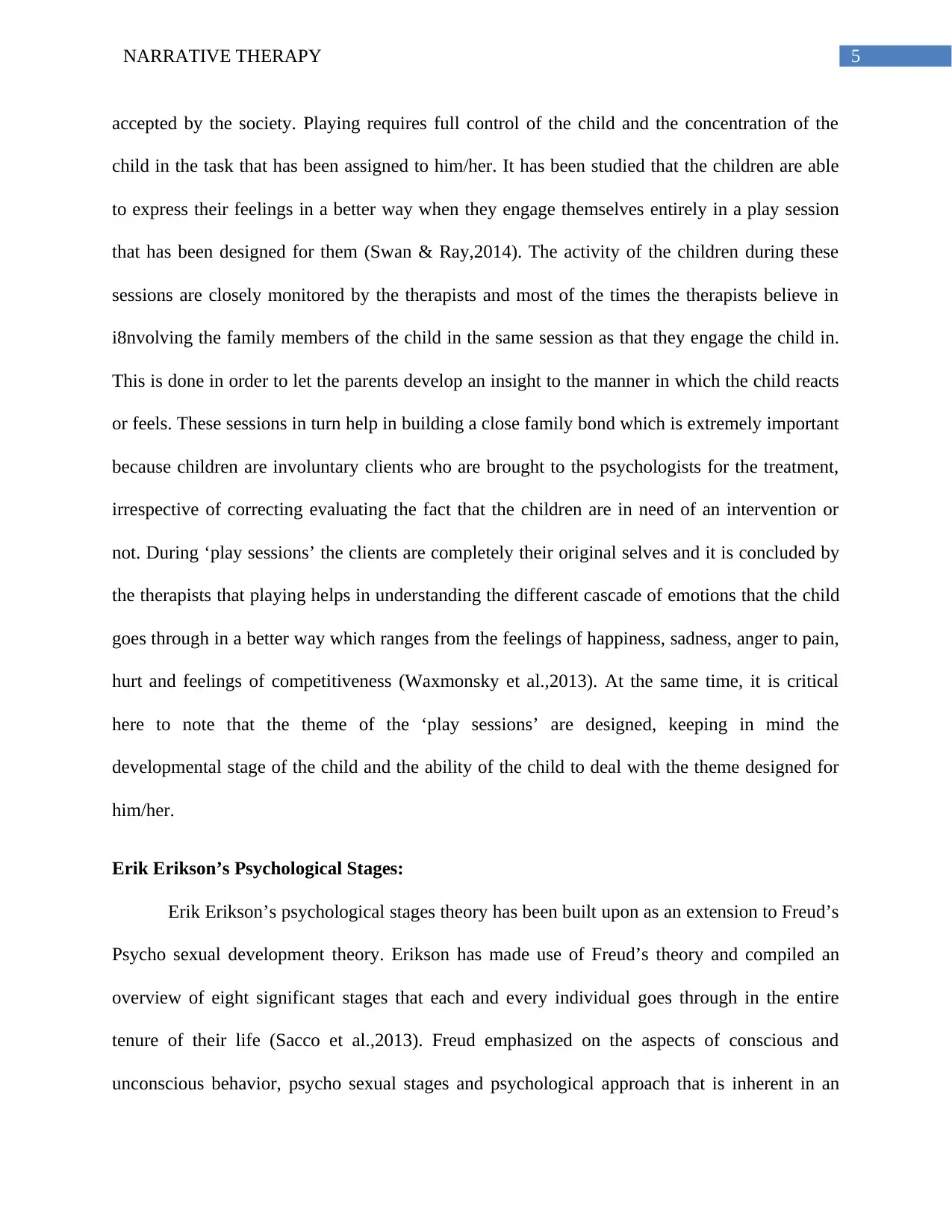
5NARRATIVE THERAPY
accepted by the society. Playing requires full control of the child and the concentration of the
child in the task that has been assigned to him/her. It has been studied that the children are able
to express their feelings in a better way when they engage themselves entirely in a play session
that has been designed for them (Swan & Ray,2014). The activity of the children during these
sessions are closely monitored by the therapists and most of the times the therapists believe in
i8nvolving the family members of the child in the same session as that they engage the child in.
This is done in order to let the parents develop an insight to the manner in which the child reacts
or feels. These sessions in turn help in building a close family bond which is extremely important
because children are involuntary clients who are brought to the psychologists for the treatment,
irrespective of correcting evaluating the fact that the children are in need of an intervention or
not. During ‘play sessions’ the clients are completely their original selves and it is concluded by
the therapists that playing helps in understanding the different cascade of emotions that the child
goes through in a better way which ranges from the feelings of happiness, sadness, anger to pain,
hurt and feelings of competitiveness (Waxmonsky et al.,2013). At the same time, it is critical
here to note that the theme of the ‘play sessions’ are designed, keeping in mind the
developmental stage of the child and the ability of the child to deal with the theme designed for
him/her.
Erik Erikson’s Psychological Stages:
Erik Erikson’s psychological stages theory has been built upon as an extension to Freud’s
Psycho sexual development theory. Erikson has made use of Freud’s theory and compiled an
overview of eight significant stages that each and every individual goes through in the entire
tenure of their life (Sacco et al.,2013). Freud emphasized on the aspects of conscious and
unconscious behavior, psycho sexual stages and psychological approach that is inherent in an
accepted by the society. Playing requires full control of the child and the concentration of the
child in the task that has been assigned to him/her. It has been studied that the children are able
to express their feelings in a better way when they engage themselves entirely in a play session
that has been designed for them (Swan & Ray,2014). The activity of the children during these
sessions are closely monitored by the therapists and most of the times the therapists believe in
i8nvolving the family members of the child in the same session as that they engage the child in.
This is done in order to let the parents develop an insight to the manner in which the child reacts
or feels. These sessions in turn help in building a close family bond which is extremely important
because children are involuntary clients who are brought to the psychologists for the treatment,
irrespective of correcting evaluating the fact that the children are in need of an intervention or
not. During ‘play sessions’ the clients are completely their original selves and it is concluded by
the therapists that playing helps in understanding the different cascade of emotions that the child
goes through in a better way which ranges from the feelings of happiness, sadness, anger to pain,
hurt and feelings of competitiveness (Waxmonsky et al.,2013). At the same time, it is critical
here to note that the theme of the ‘play sessions’ are designed, keeping in mind the
developmental stage of the child and the ability of the child to deal with the theme designed for
him/her.
Erik Erikson’s Psychological Stages:
Erik Erikson’s psychological stages theory has been built upon as an extension to Freud’s
Psycho sexual development theory. Erikson has made use of Freud’s theory and compiled an
overview of eight significant stages that each and every individual goes through in the entire
tenure of their life (Sacco et al.,2013). Freud emphasized on the aspects of conscious and
unconscious behavior, psycho sexual stages and psychological approach that is inherent in an
⊘ This is a preview!⊘
Do you want full access?
Subscribe today to unlock all pages.

Trusted by 1+ million students worldwide
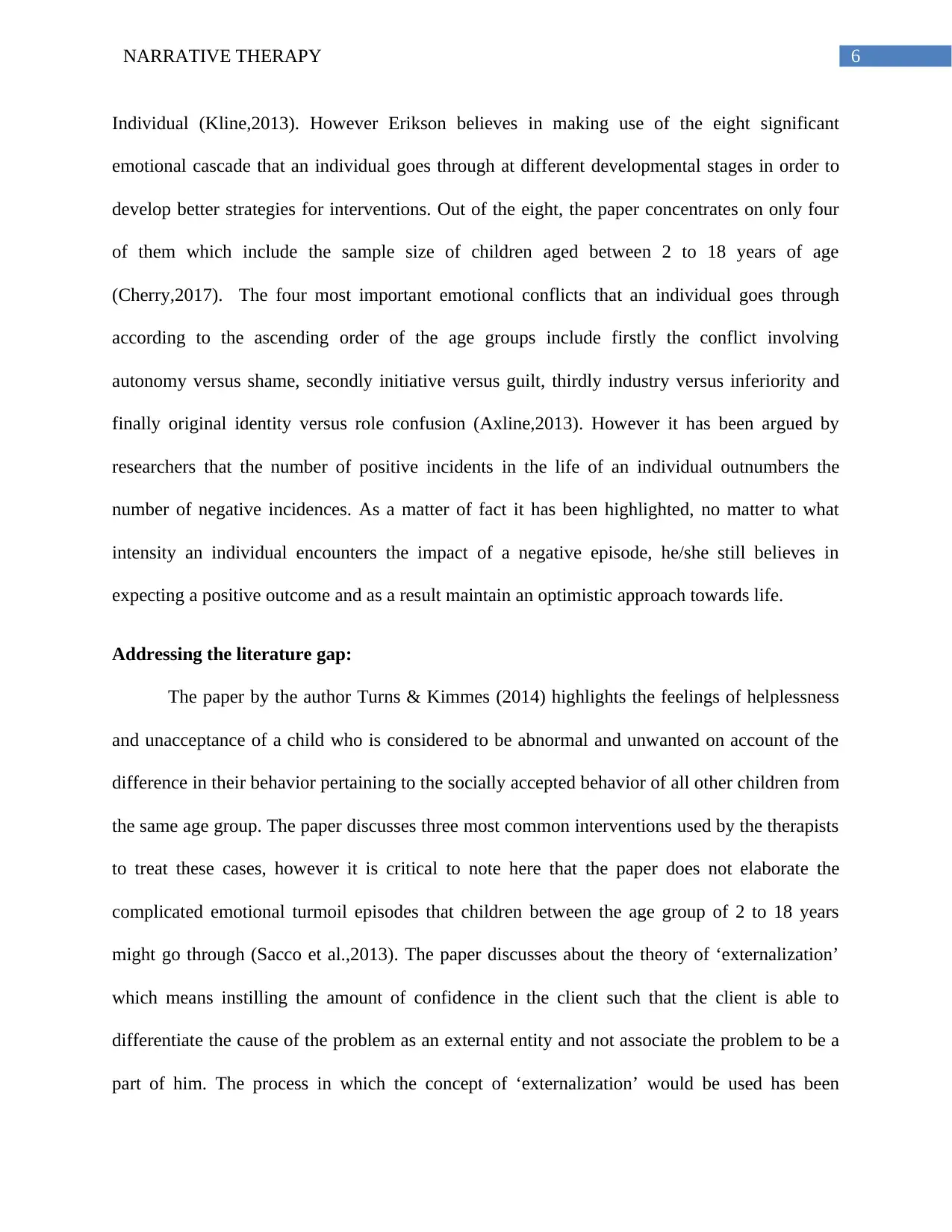
6NARRATIVE THERAPY
Individual (Kline,2013). However Erikson believes in making use of the eight significant
emotional cascade that an individual goes through at different developmental stages in order to
develop better strategies for interventions. Out of the eight, the paper concentrates on only four
of them which include the sample size of children aged between 2 to 18 years of age
(Cherry,2017). The four most important emotional conflicts that an individual goes through
according to the ascending order of the age groups include firstly the conflict involving
autonomy versus shame, secondly initiative versus guilt, thirdly industry versus inferiority and
finally original identity versus role confusion (Axline,2013). However it has been argued by
researchers that the number of positive incidents in the life of an individual outnumbers the
number of negative incidences. As a matter of fact it has been highlighted, no matter to what
intensity an individual encounters the impact of a negative episode, he/she still believes in
expecting a positive outcome and as a result maintain an optimistic approach towards life.
Addressing the literature gap:
The paper by the author Turns & Kimmes (2014) highlights the feelings of helplessness
and unacceptance of a child who is considered to be abnormal and unwanted on account of the
difference in their behavior pertaining to the socially accepted behavior of all other children from
the same age group. The paper discusses three most common interventions used by the therapists
to treat these cases, however it is critical to note here that the paper does not elaborate the
complicated emotional turmoil episodes that children between the age group of 2 to 18 years
might go through (Sacco et al.,2013). The paper discusses about the theory of ‘externalization’
which means instilling the amount of confidence in the client such that the client is able to
differentiate the cause of the problem as an external entity and not associate the problem to be a
part of him. The process in which the concept of ‘externalization’ would be used has been
Individual (Kline,2013). However Erikson believes in making use of the eight significant
emotional cascade that an individual goes through at different developmental stages in order to
develop better strategies for interventions. Out of the eight, the paper concentrates on only four
of them which include the sample size of children aged between 2 to 18 years of age
(Cherry,2017). The four most important emotional conflicts that an individual goes through
according to the ascending order of the age groups include firstly the conflict involving
autonomy versus shame, secondly initiative versus guilt, thirdly industry versus inferiority and
finally original identity versus role confusion (Axline,2013). However it has been argued by
researchers that the number of positive incidents in the life of an individual outnumbers the
number of negative incidences. As a matter of fact it has been highlighted, no matter to what
intensity an individual encounters the impact of a negative episode, he/she still believes in
expecting a positive outcome and as a result maintain an optimistic approach towards life.
Addressing the literature gap:
The paper by the author Turns & Kimmes (2014) highlights the feelings of helplessness
and unacceptance of a child who is considered to be abnormal and unwanted on account of the
difference in their behavior pertaining to the socially accepted behavior of all other children from
the same age group. The paper discusses three most common interventions used by the therapists
to treat these cases, however it is critical to note here that the paper does not elaborate the
complicated emotional turmoil episodes that children between the age group of 2 to 18 years
might go through (Sacco et al.,2013). The paper discusses about the theory of ‘externalization’
which means instilling the amount of confidence in the client such that the client is able to
differentiate the cause of the problem as an external entity and not associate the problem to be a
part of him. The process in which the concept of ‘externalization’ would be used has been
Paraphrase This Document
Need a fresh take? Get an instant paraphrase of this document with our AI Paraphraser
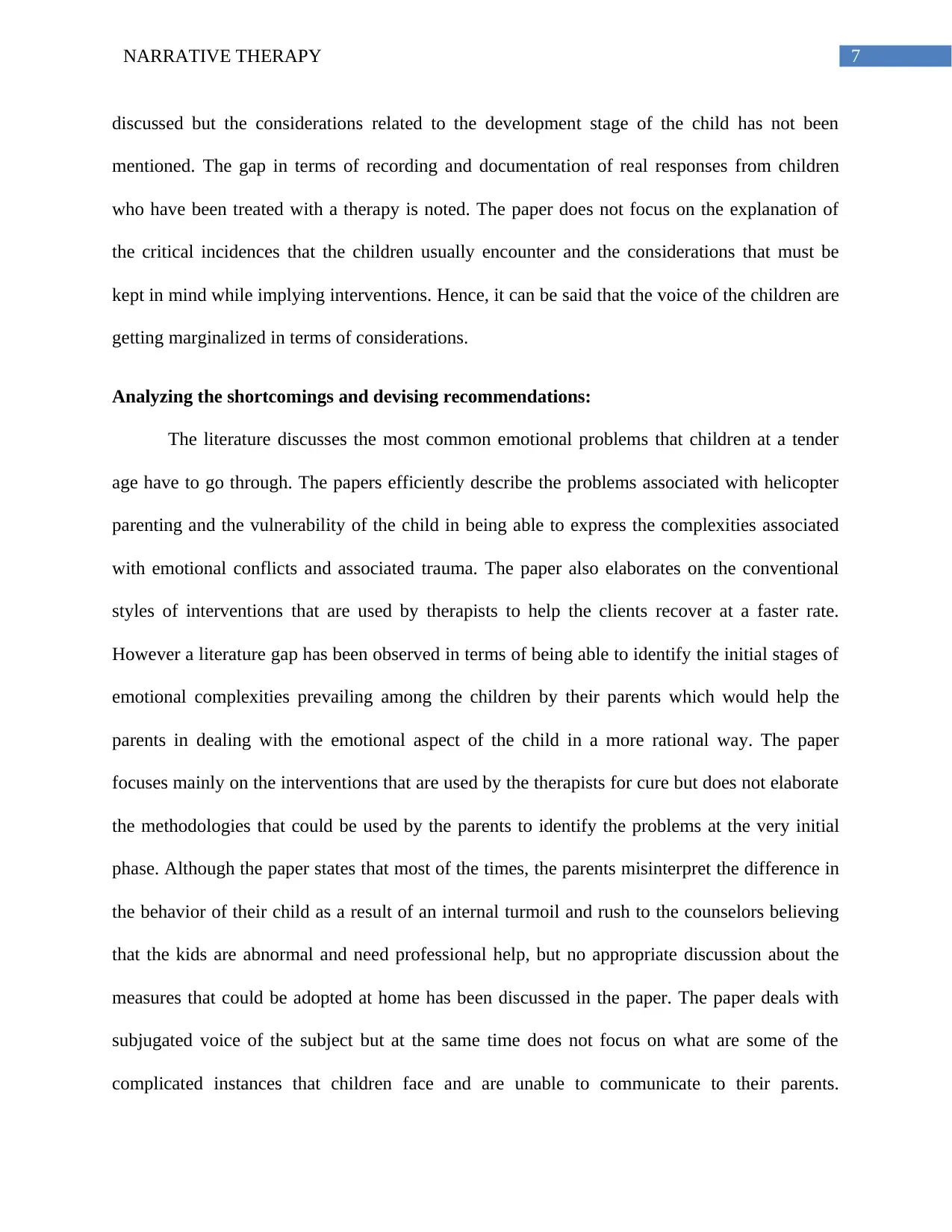
7NARRATIVE THERAPY
discussed but the considerations related to the development stage of the child has not been
mentioned. The gap in terms of recording and documentation of real responses from children
who have been treated with a therapy is noted. The paper does not focus on the explanation of
the critical incidences that the children usually encounter and the considerations that must be
kept in mind while implying interventions. Hence, it can be said that the voice of the children are
getting marginalized in terms of considerations.
Analyzing the shortcomings and devising recommendations:
The literature discusses the most common emotional problems that children at a tender
age have to go through. The papers efficiently describe the problems associated with helicopter
parenting and the vulnerability of the child in being able to express the complexities associated
with emotional conflicts and associated trauma. The paper also elaborates on the conventional
styles of interventions that are used by therapists to help the clients recover at a faster rate.
However a literature gap has been observed in terms of being able to identify the initial stages of
emotional complexities prevailing among the children by their parents which would help the
parents in dealing with the emotional aspect of the child in a more rational way. The paper
focuses mainly on the interventions that are used by the therapists for cure but does not elaborate
the methodologies that could be used by the parents to identify the problems at the very initial
phase. Although the paper states that most of the times, the parents misinterpret the difference in
the behavior of their child as a result of an internal turmoil and rush to the counselors believing
that the kids are abnormal and need professional help, but no appropriate discussion about the
measures that could be adopted at home has been discussed in the paper. The paper deals with
subjugated voice of the subject but at the same time does not focus on what are some of the
complicated instances that children face and are unable to communicate to their parents.
discussed but the considerations related to the development stage of the child has not been
mentioned. The gap in terms of recording and documentation of real responses from children
who have been treated with a therapy is noted. The paper does not focus on the explanation of
the critical incidences that the children usually encounter and the considerations that must be
kept in mind while implying interventions. Hence, it can be said that the voice of the children are
getting marginalized in terms of considerations.
Analyzing the shortcomings and devising recommendations:
The literature discusses the most common emotional problems that children at a tender
age have to go through. The papers efficiently describe the problems associated with helicopter
parenting and the vulnerability of the child in being able to express the complexities associated
with emotional conflicts and associated trauma. The paper also elaborates on the conventional
styles of interventions that are used by therapists to help the clients recover at a faster rate.
However a literature gap has been observed in terms of being able to identify the initial stages of
emotional complexities prevailing among the children by their parents which would help the
parents in dealing with the emotional aspect of the child in a more rational way. The paper
focuses mainly on the interventions that are used by the therapists for cure but does not elaborate
the methodologies that could be used by the parents to identify the problems at the very initial
phase. Although the paper states that most of the times, the parents misinterpret the difference in
the behavior of their child as a result of an internal turmoil and rush to the counselors believing
that the kids are abnormal and need professional help, but no appropriate discussion about the
measures that could be adopted at home has been discussed in the paper. The paper deals with
subjugated voice of the subject but at the same time does not focus on what are some of the
complicated instances that children face and are unable to communicate to their parents.
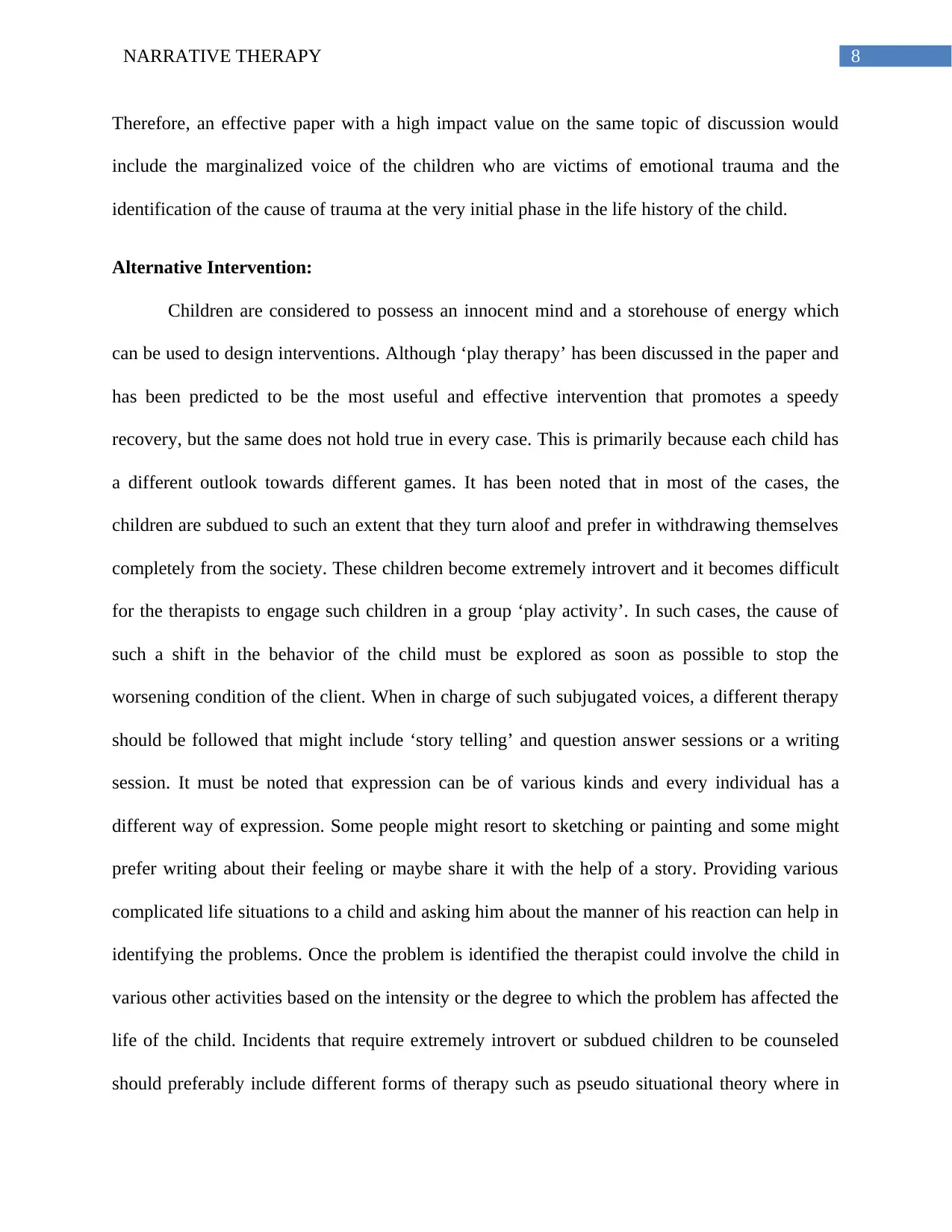
8NARRATIVE THERAPY
Therefore, an effective paper with a high impact value on the same topic of discussion would
include the marginalized voice of the children who are victims of emotional trauma and the
identification of the cause of trauma at the very initial phase in the life history of the child.
Alternative Intervention:
Children are considered to possess an innocent mind and a storehouse of energy which
can be used to design interventions. Although ‘play therapy’ has been discussed in the paper and
has been predicted to be the most useful and effective intervention that promotes a speedy
recovery, but the same does not hold true in every case. This is primarily because each child has
a different outlook towards different games. It has been noted that in most of the cases, the
children are subdued to such an extent that they turn aloof and prefer in withdrawing themselves
completely from the society. These children become extremely introvert and it becomes difficult
for the therapists to engage such children in a group ‘play activity’. In such cases, the cause of
such a shift in the behavior of the child must be explored as soon as possible to stop the
worsening condition of the client. When in charge of such subjugated voices, a different therapy
should be followed that might include ‘story telling’ and question answer sessions or a writing
session. It must be noted that expression can be of various kinds and every individual has a
different way of expression. Some people might resort to sketching or painting and some might
prefer writing about their feeling or maybe share it with the help of a story. Providing various
complicated life situations to a child and asking him about the manner of his reaction can help in
identifying the problems. Once the problem is identified the therapist could involve the child in
various other activities based on the intensity or the degree to which the problem has affected the
life of the child. Incidents that require extremely introvert or subdued children to be counseled
should preferably include different forms of therapy such as pseudo situational theory where in
Therefore, an effective paper with a high impact value on the same topic of discussion would
include the marginalized voice of the children who are victims of emotional trauma and the
identification of the cause of trauma at the very initial phase in the life history of the child.
Alternative Intervention:
Children are considered to possess an innocent mind and a storehouse of energy which
can be used to design interventions. Although ‘play therapy’ has been discussed in the paper and
has been predicted to be the most useful and effective intervention that promotes a speedy
recovery, but the same does not hold true in every case. This is primarily because each child has
a different outlook towards different games. It has been noted that in most of the cases, the
children are subdued to such an extent that they turn aloof and prefer in withdrawing themselves
completely from the society. These children become extremely introvert and it becomes difficult
for the therapists to engage such children in a group ‘play activity’. In such cases, the cause of
such a shift in the behavior of the child must be explored as soon as possible to stop the
worsening condition of the client. When in charge of such subjugated voices, a different therapy
should be followed that might include ‘story telling’ and question answer sessions or a writing
session. It must be noted that expression can be of various kinds and every individual has a
different way of expression. Some people might resort to sketching or painting and some might
prefer writing about their feeling or maybe share it with the help of a story. Providing various
complicated life situations to a child and asking him about the manner of his reaction can help in
identifying the problems. Once the problem is identified the therapist could involve the child in
various other activities based on the intensity or the degree to which the problem has affected the
life of the child. Incidents that require extremely introvert or subdued children to be counseled
should preferably include different forms of therapy such as pseudo situational theory where in
⊘ This is a preview!⊘
Do you want full access?
Subscribe today to unlock all pages.

Trusted by 1+ million students worldwide
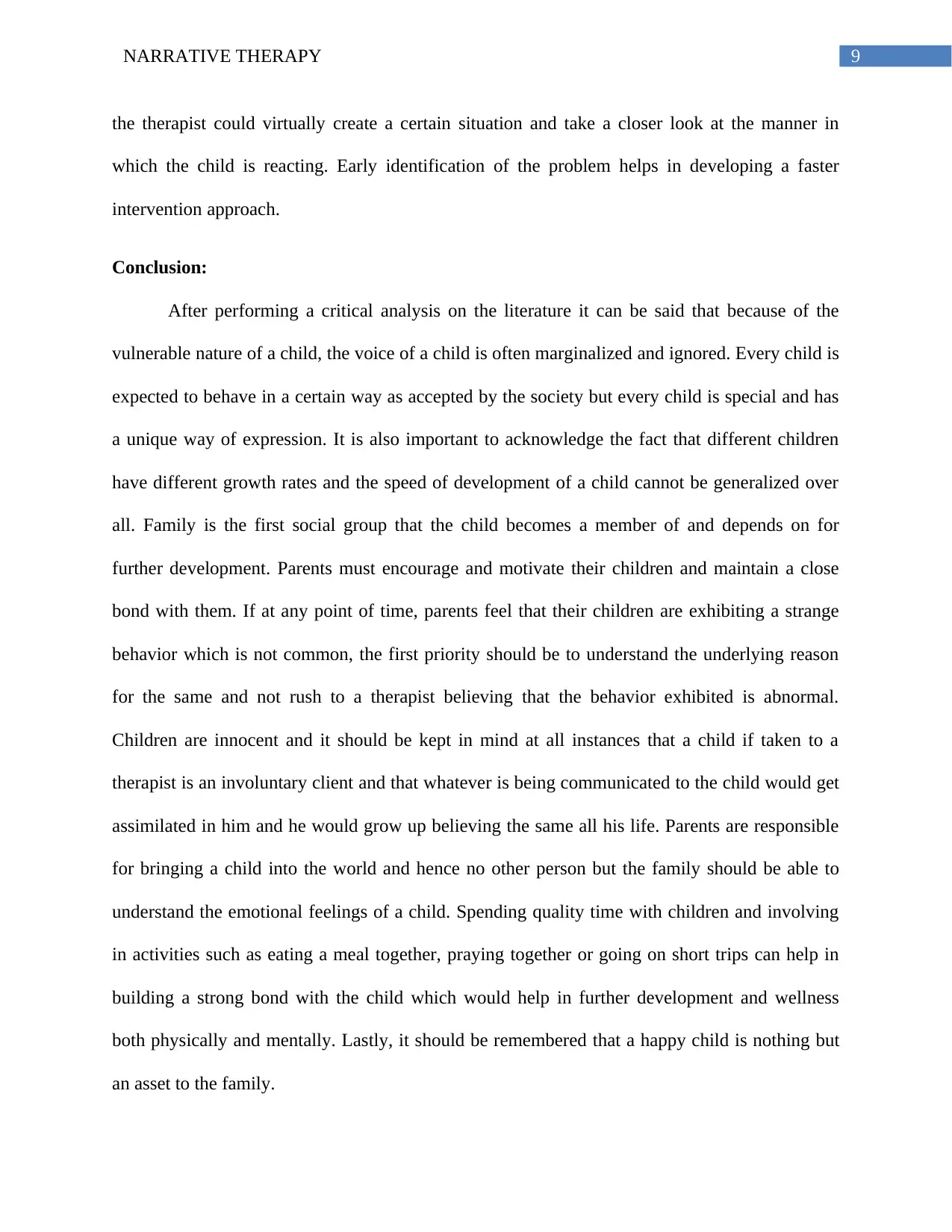
9NARRATIVE THERAPY
the therapist could virtually create a certain situation and take a closer look at the manner in
which the child is reacting. Early identification of the problem helps in developing a faster
intervention approach.
Conclusion:
After performing a critical analysis on the literature it can be said that because of the
vulnerable nature of a child, the voice of a child is often marginalized and ignored. Every child is
expected to behave in a certain way as accepted by the society but every child is special and has
a unique way of expression. It is also important to acknowledge the fact that different children
have different growth rates and the speed of development of a child cannot be generalized over
all. Family is the first social group that the child becomes a member of and depends on for
further development. Parents must encourage and motivate their children and maintain a close
bond with them. If at any point of time, parents feel that their children are exhibiting a strange
behavior which is not common, the first priority should be to understand the underlying reason
for the same and not rush to a therapist believing that the behavior exhibited is abnormal.
Children are innocent and it should be kept in mind at all instances that a child if taken to a
therapist is an involuntary client and that whatever is being communicated to the child would get
assimilated in him and he would grow up believing the same all his life. Parents are responsible
for bringing a child into the world and hence no other person but the family should be able to
understand the emotional feelings of a child. Spending quality time with children and involving
in activities such as eating a meal together, praying together or going on short trips can help in
building a strong bond with the child which would help in further development and wellness
both physically and mentally. Lastly, it should be remembered that a happy child is nothing but
an asset to the family.
the therapist could virtually create a certain situation and take a closer look at the manner in
which the child is reacting. Early identification of the problem helps in developing a faster
intervention approach.
Conclusion:
After performing a critical analysis on the literature it can be said that because of the
vulnerable nature of a child, the voice of a child is often marginalized and ignored. Every child is
expected to behave in a certain way as accepted by the society but every child is special and has
a unique way of expression. It is also important to acknowledge the fact that different children
have different growth rates and the speed of development of a child cannot be generalized over
all. Family is the first social group that the child becomes a member of and depends on for
further development. Parents must encourage and motivate their children and maintain a close
bond with them. If at any point of time, parents feel that their children are exhibiting a strange
behavior which is not common, the first priority should be to understand the underlying reason
for the same and not rush to a therapist believing that the behavior exhibited is abnormal.
Children are innocent and it should be kept in mind at all instances that a child if taken to a
therapist is an involuntary client and that whatever is being communicated to the child would get
assimilated in him and he would grow up believing the same all his life. Parents are responsible
for bringing a child into the world and hence no other person but the family should be able to
understand the emotional feelings of a child. Spending quality time with children and involving
in activities such as eating a meal together, praying together or going on short trips can help in
building a strong bond with the child which would help in further development and wellness
both physically and mentally. Lastly, it should be remembered that a happy child is nothing but
an asset to the family.
Paraphrase This Document
Need a fresh take? Get an instant paraphrase of this document with our AI Paraphraser
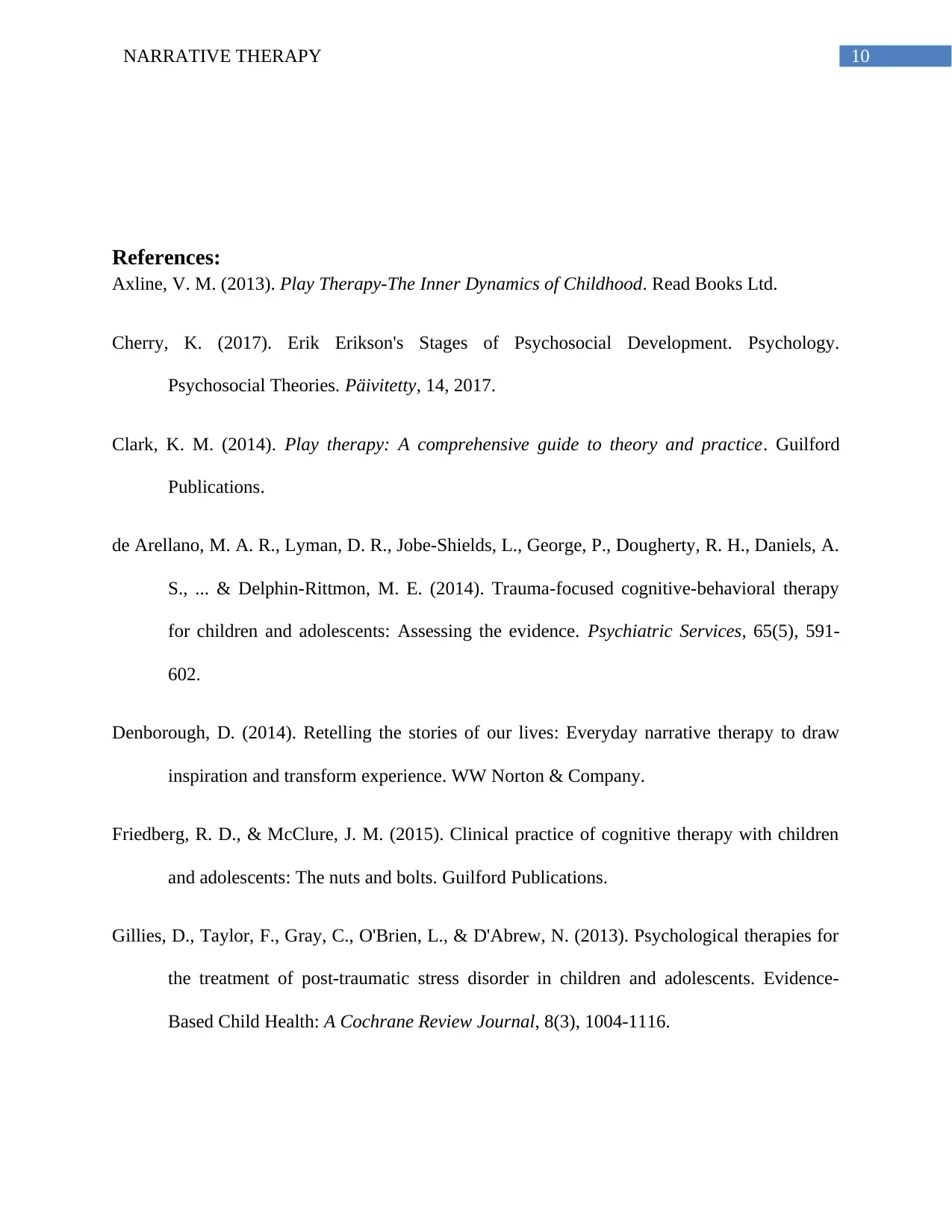
10NARRATIVE THERAPY
References:
Axline, V. M. (2013). Play Therapy-The Inner Dynamics of Childhood. Read Books Ltd.
Cherry, K. (2017). Erik Erikson's Stages of Psychosocial Development. Psychology.
Psychosocial Theories. Päivitetty, 14, 2017.
Clark, K. M. (2014). Play therapy: A comprehensive guide to theory and practice. Guilford
Publications.
de Arellano, M. A. R., Lyman, D. R., Jobe-Shields, L., George, P., Dougherty, R. H., Daniels, A.
S., ... & Delphin-Rittmon, M. E. (2014). Trauma-focused cognitive-behavioral therapy
for children and adolescents: Assessing the evidence. Psychiatric Services, 65(5), 591-
602.
Denborough, D. (2014). Retelling the stories of our lives: Everyday narrative therapy to draw
inspiration and transform experience. WW Norton & Company.
Friedberg, R. D., & McClure, J. M. (2015). Clinical practice of cognitive therapy with children
and adolescents: The nuts and bolts. Guilford Publications.
Gillies, D., Taylor, F., Gray, C., O'Brien, L., & D'Abrew, N. (2013). Psychological therapies for
the treatment of post‐traumatic stress disorder in children and adolescents. Evidence‐
Based Child Health: A Cochrane Review Journal, 8(3), 1004-1116.
References:
Axline, V. M. (2013). Play Therapy-The Inner Dynamics of Childhood. Read Books Ltd.
Cherry, K. (2017). Erik Erikson's Stages of Psychosocial Development. Psychology.
Psychosocial Theories. Päivitetty, 14, 2017.
Clark, K. M. (2014). Play therapy: A comprehensive guide to theory and practice. Guilford
Publications.
de Arellano, M. A. R., Lyman, D. R., Jobe-Shields, L., George, P., Dougherty, R. H., Daniels, A.
S., ... & Delphin-Rittmon, M. E. (2014). Trauma-focused cognitive-behavioral therapy
for children and adolescents: Assessing the evidence. Psychiatric Services, 65(5), 591-
602.
Denborough, D. (2014). Retelling the stories of our lives: Everyday narrative therapy to draw
inspiration and transform experience. WW Norton & Company.
Friedberg, R. D., & McClure, J. M. (2015). Clinical practice of cognitive therapy with children
and adolescents: The nuts and bolts. Guilford Publications.
Gillies, D., Taylor, F., Gray, C., O'Brien, L., & D'Abrew, N. (2013). Psychological therapies for
the treatment of post‐traumatic stress disorder in children and adolescents. Evidence‐
Based Child Health: A Cochrane Review Journal, 8(3), 1004-1116.
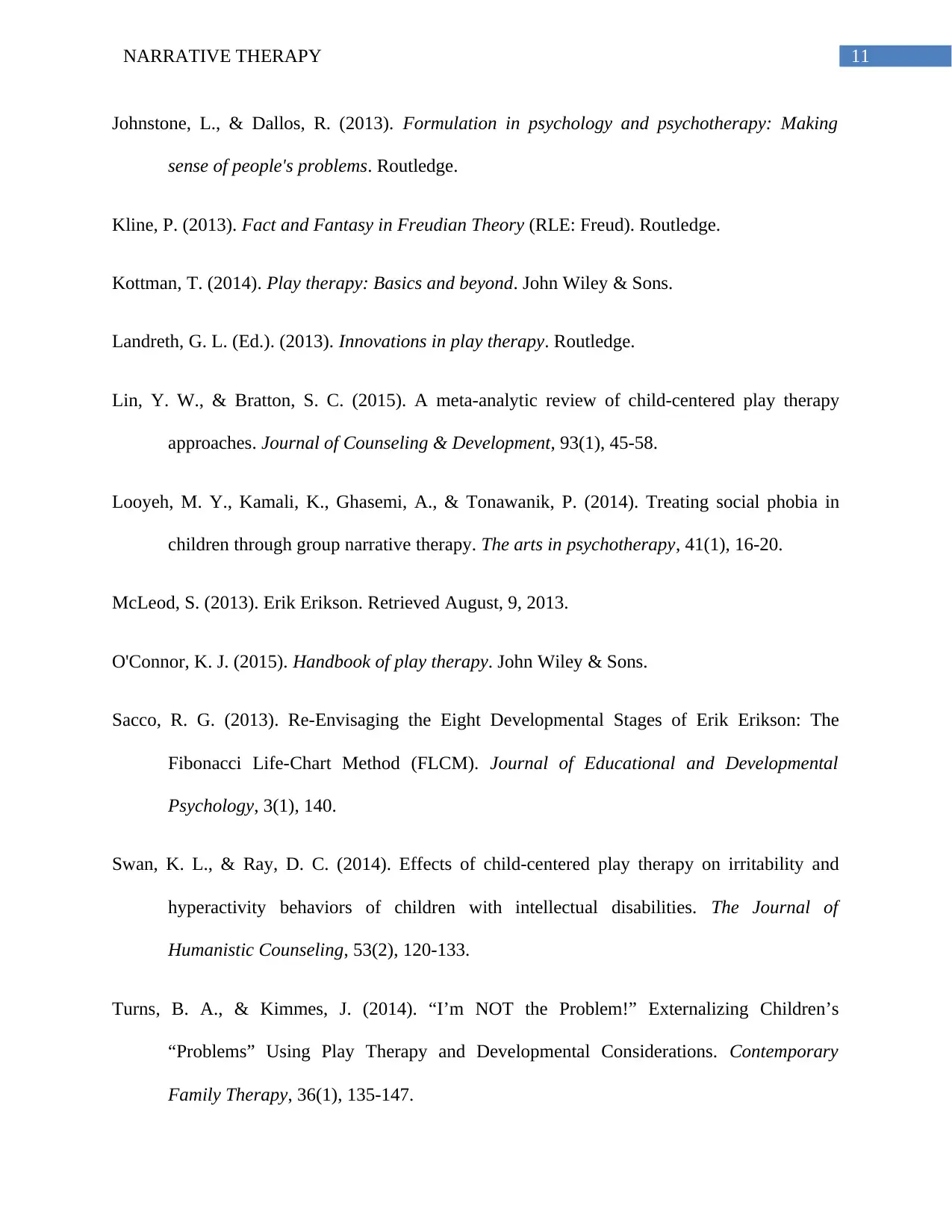
11NARRATIVE THERAPY
Johnstone, L., & Dallos, R. (2013). Formulation in psychology and psychotherapy: Making
sense of people's problems. Routledge.
Kline, P. (2013). Fact and Fantasy in Freudian Theory (RLE: Freud). Routledge.
Kottman, T. (2014). Play therapy: Basics and beyond. John Wiley & Sons.
Landreth, G. L. (Ed.). (2013). Innovations in play therapy. Routledge.
Lin, Y. W., & Bratton, S. C. (2015). A meta‐analytic review of child‐centered play therapy
approaches. Journal of Counseling & Development, 93(1), 45-58.
Looyeh, M. Y., Kamali, K., Ghasemi, A., & Tonawanik, P. (2014). Treating social phobia in
children through group narrative therapy. The arts in psychotherapy, 41(1), 16-20.
McLeod, S. (2013). Erik Erikson. Retrieved August, 9, 2013.
O'Connor, K. J. (2015). Handbook of play therapy. John Wiley & Sons.
Sacco, R. G. (2013). Re-Envisaging the Eight Developmental Stages of Erik Erikson: The
Fibonacci Life-Chart Method (FLCM). Journal of Educational and Developmental
Psychology, 3(1), 140.
Swan, K. L., & Ray, D. C. (2014). Effects of child‐centered play therapy on irritability and
hyperactivity behaviors of children with intellectual disabilities. The Journal of
Humanistic Counseling, 53(2), 120-133.
Turns, B. A., & Kimmes, J. (2014). “I’m NOT the Problem!” Externalizing Children’s
“Problems” Using Play Therapy and Developmental Considerations. Contemporary
Family Therapy, 36(1), 135-147.
Johnstone, L., & Dallos, R. (2013). Formulation in psychology and psychotherapy: Making
sense of people's problems. Routledge.
Kline, P. (2013). Fact and Fantasy in Freudian Theory (RLE: Freud). Routledge.
Kottman, T. (2014). Play therapy: Basics and beyond. John Wiley & Sons.
Landreth, G. L. (Ed.). (2013). Innovations in play therapy. Routledge.
Lin, Y. W., & Bratton, S. C. (2015). A meta‐analytic review of child‐centered play therapy
approaches. Journal of Counseling & Development, 93(1), 45-58.
Looyeh, M. Y., Kamali, K., Ghasemi, A., & Tonawanik, P. (2014). Treating social phobia in
children through group narrative therapy. The arts in psychotherapy, 41(1), 16-20.
McLeod, S. (2013). Erik Erikson. Retrieved August, 9, 2013.
O'Connor, K. J. (2015). Handbook of play therapy. John Wiley & Sons.
Sacco, R. G. (2013). Re-Envisaging the Eight Developmental Stages of Erik Erikson: The
Fibonacci Life-Chart Method (FLCM). Journal of Educational and Developmental
Psychology, 3(1), 140.
Swan, K. L., & Ray, D. C. (2014). Effects of child‐centered play therapy on irritability and
hyperactivity behaviors of children with intellectual disabilities. The Journal of
Humanistic Counseling, 53(2), 120-133.
Turns, B. A., & Kimmes, J. (2014). “I’m NOT the Problem!” Externalizing Children’s
“Problems” Using Play Therapy and Developmental Considerations. Contemporary
Family Therapy, 36(1), 135-147.
⊘ This is a preview!⊘
Do you want full access?
Subscribe today to unlock all pages.

Trusted by 1+ million students worldwide
1 out of 13
Your All-in-One AI-Powered Toolkit for Academic Success.
+13062052269
info@desklib.com
Available 24*7 on WhatsApp / Email
![[object Object]](/_next/static/media/star-bottom.7253800d.svg)
Unlock your academic potential
Copyright © 2020–2026 A2Z Services. All Rights Reserved. Developed and managed by ZUCOL.